

Compact Muon Solenoid
LHC, CERN
| CMS-TOP-15-015 ; CERN-EP-2017-018 | ||
| Measurement of the jet mass in highly boosted $\mathrm{ t \bar{t} }$ events from pp collisions at $\sqrt{s}=$ 8 TeV | ||
| CMS Collaboration | ||
| 18 March 2017 | ||
| Eur. Phys. J. C 77 (2017) 467 | ||
| Abstract: The first measurement of the jet mass $m_{\text{jet}}$ of top quark jets produced in $\mathrm{ t \bar{t} }$ events from pp collisions at $\sqrt{s}=$ 8 TeV is reported for the jet with the largest transverse momentum $p_{\mathrm{T}}$ in highly boosted hadronic top quark decays. The data sample, collected with the CMS detector, corresponds to an integrated luminosity of 19.7 fb$^{-1}$. The measurement is performed in the lepton+jets channel in which the products of the semileptonic decay $\mathrm{ t } \to \mathrm{ b }\mathrm{ W }$ with $\mathrm{ W }\to\ell \nu$ where $\ell$ is an electron or muon, are used to select $\mathrm{ t \bar{t} }$ events with large Lorentz boosts. The products of the fully hadronic decay $\mathrm{ t } \to \mathrm{ b }\mathrm{ W }$ with $\mathrm{ W }\to\mathrm{ q }\mathrm{ \bar{q} }'$ are reconstructed using a single Cambridge-Aachen jet with distance parameter $R=$ 1.2, and $p_{\mathrm{T}} >$ 400 GeV. The $\mathrm{ t \bar{t} }$ cross section as a function of $m_{\text{jet}}$ is unfolded at the particle level and is used to test the modelling of highly boosted top quark production. The peak position of the $m_{\text{jet}}$ distribution is sensitive to the top quark mass $m_{\mathrm{ t }}$, and the data are used to extract a value of $m_{\mathrm{ t }}$ to assess this sensitivity. | ||
| Links: e-print arXiv:1703.06330 [hep-ex] (PDF) ; CDS record ; inSPIRE record ; CADI line (restricted) ; | ||
| Figures | |
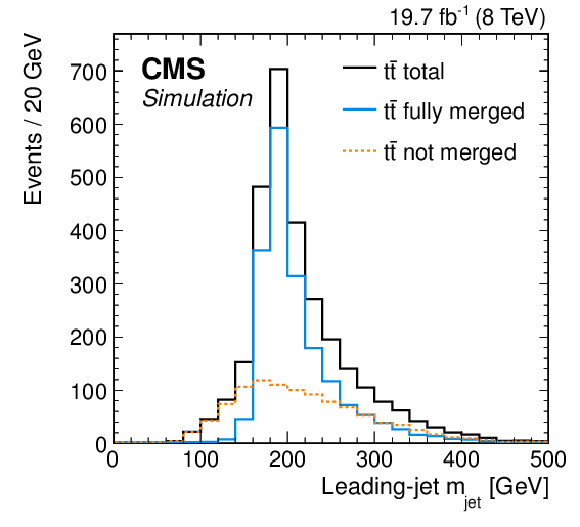
png pdf |
Figure 1:
Simulated mass distributions of the leading jet in ${\mathrm{ t }\mathrm{ \bar{t} } }$ events for the $\ell $+jets channel at the particle level. The events are generated with POWHEG+PYTHIA, and normalised to the integrated luminosity of the data. The distribution for the total number of selected events (dark solid line) is compared to events where the leading jet originates from the fully hadronic top quark decay (light solid line, "fully merged''), and to events where the leading jet does not include all the remnants (dotted line, "not merged'') from the fully hadronic top quark decay. |

png pdf |
Figure 2:
Distributions of $ {p_{\mathrm {T}}} $ (left ) and $\eta $ (right ) of the leading jet from data (points) and simulation (filled histograms). The vertical bars on the points show the statistical uncertainty and the horizontal bars show the bin widths. The electron and muon channels are shown combined. The ${\mathrm{ t }\mathrm{ \bar{t} } } $ sample is scaled such that the number of simulated events matches the number of selected events observed in data. The hatched region shows the total uncertainty in the simulation, including the statistical and experimental systematic uncertainties. The panels below show the ratio of the data to the simulation. The uncertainty bands include the statistical and experimental systematic uncertainties, where the statistical (light grey) and total (dark grey) uncertainties are shown separately in the ratio. |
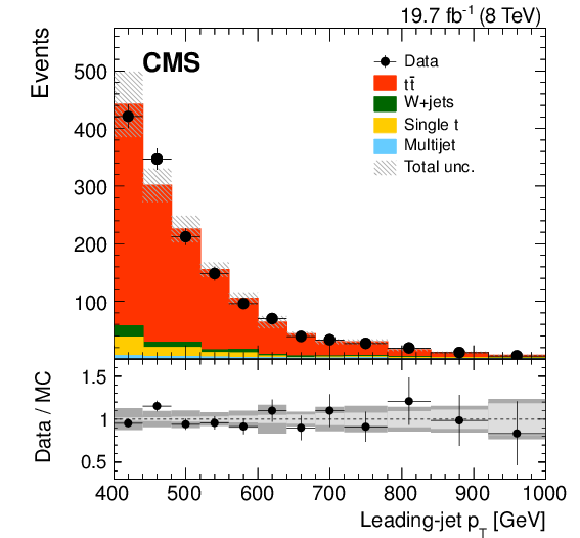
png pdf |
Figure 2-a:
Distributions of $ {p_{\mathrm {T}}} $ of the leading jet from data (points) and simulation (filled histograms). The vertical bars on the points show the statistical uncertainty and the horizontal bars show the bin widths. The electron and muon channels are shown combined. The ${\mathrm{ t }\mathrm{ \bar{t} } } $ sample is scaled such that the number of simulated events matches the number of selected events observed in data. The hatched region shows the total uncertainty in the simulation, including the statistical and experimental systematic uncertainties. The panel below shows the ratio of the data to the simulation. The uncertainty bands include the statistical and experimental systematic uncertainties, where the statistical (light grey) and total (dark grey) uncertainties are shown separately in the ratio. |
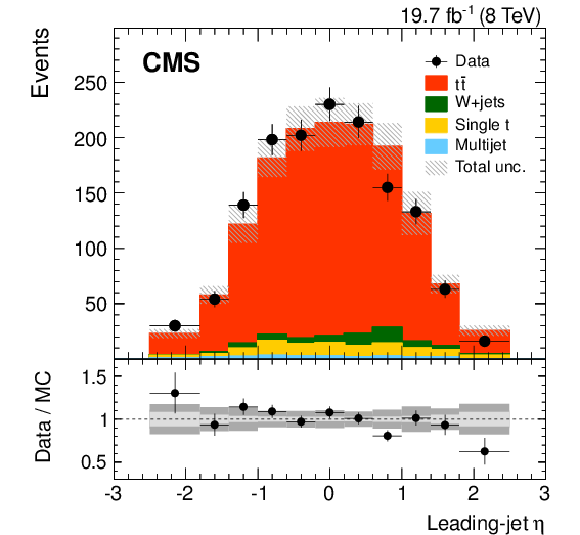
png pdf |
Figure 2-b:
Distributions of $\eta $ of the leading jet from data (points) and simulation (filled histograms). The vertical bars on the points show the statistical uncertainty and the horizontal bars show the bin widths. The electron and muon channels are shown combined. The ${\mathrm{ t }\mathrm{ \bar{t} } } $ sample is scaled such that the number of simulated events matches the number of selected events observed in data. The hatched region shows the total uncertainty in the simulation, including the statistical and experimental systematic uncertainties. The panel below shows the ratio of the data to the simulation. The uncertainty bands include the statistical and experimental systematic uncertainties, where the statistical (light grey) and total (dark grey) uncertainties are shown separately in the ratio. |
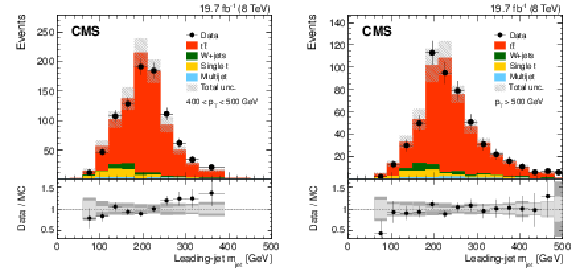
png pdf |
Figure 3:
Distributions of the leading-jet invariant mass from data (points) and simulation (filled histograms). The vertical bars on the points show the statistical uncertainty and the horizontal bars show the bin widths for the combined electron and muon channels. The distributions for $ {p_{\mathrm {T}}} $ bins of 400 $ < {p_{\mathrm {T}}} < $ 500 GeV (left ) and $ {p_{\mathrm {T}}} > $ 500 GeV (right ) are given. The ${\mathrm{ t }\mathrm{ \bar{t} } } $ simulation is scaled such that the number of simulated events matches the number of selected events observed in data. The hatched region shows the total uncertainty in the simulation, including the statistical and experimental systematic uncertainties. The panels below show the ratio of the data to the simulation. The uncertainty bands include the statistical and experimental systematic uncertainties, where the statistical (light grey) and total (dark grey) uncertainties are shown separately in the ratio. |
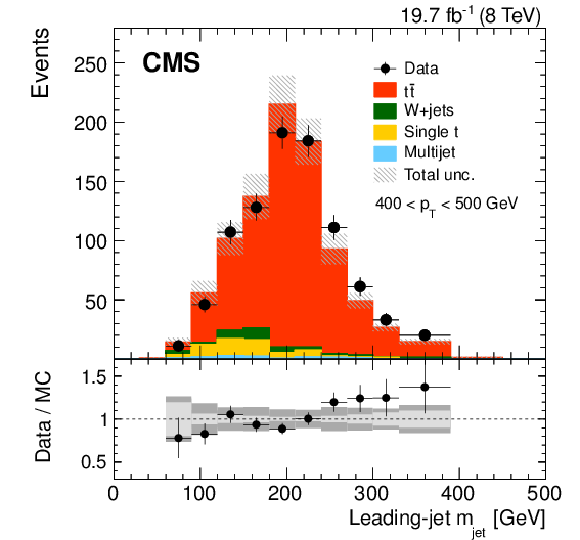
png pdf |
Figure 3-a:
Distributions of the leading-jet invariant mass from data (points) and simulation (filled histograms). The vertical bars on the points show the statistical uncertainty and the horizontal bars show the bin widths for the combined electron and muon channels. The distribution for ${p_{\mathrm {T}}} $ bins of 400 $ < {p_{\mathrm {T}}} < $ 500 GeV is given. The ${\mathrm{ t }\mathrm{ \bar{t} } } $ simulation is scaled such that the number of simulated events matches the number of selected events observed in data. The hatched region shows the total uncertainty in the simulation, including the statistical and experimental systematic uncertainties. The panel below shows the ratio of the data to the simulation. The uncertainty bands include the statistical and experimental systematic uncertainties, where the statistical (light grey) and total (dark grey) uncertainties are shown separately in the ratio. |
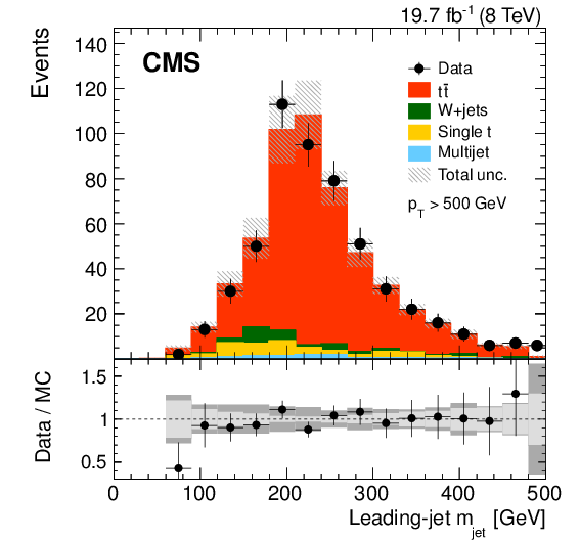
png pdf |
Figure 3-b:
Distributions of the leading-jet invariant mass from data (points) and simulation (filled histograms). The vertical bars on the points show the statistical uncertainty and the horizontal bars show the bin widths for the combined electron and muon channels. The distribution for $ {p_{\mathrm {T}}} $ bins of $ {p_{\mathrm {T}}} > $ 500 GeV is given. The ${\mathrm{ t }\mathrm{ \bar{t} } } $ simulation is scaled such that the number of simulated events matches the number of selected events observed in data. The hatched region shows the total uncertainty in the simulation, including the statistical and experimental systematic uncertainties. The panel below shows the ratio of the data to the simulation. The uncertainty bands include the statistical and experimental systematic uncertainties, where the statistical (light grey) and total (dark grey) uncertainties are shown separately in the ratio. |
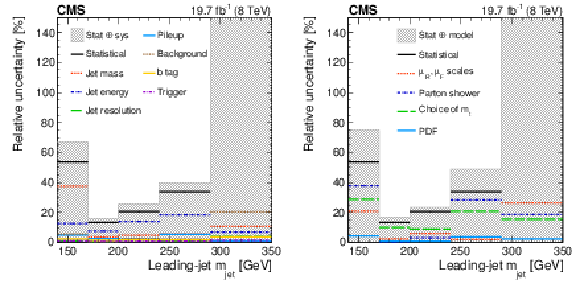
png pdf |
Figure 4:
Statistical uncertainties compared to the individual experimental systematic uncertainties (left ), and statistical uncertainties compared to the systematic uncertainties originating from the modelling of ${\mathrm{ t }\mathrm{ \bar{t} } }$ production (right ), as a function of the leading-jet mass. The total uncertainties are indicated by the grey cross-hatched regions. The statistical and total uncertainties in the last bin are around 300% and exceed the vertical scale. The size of the horizontal bars represents the bin widths. |
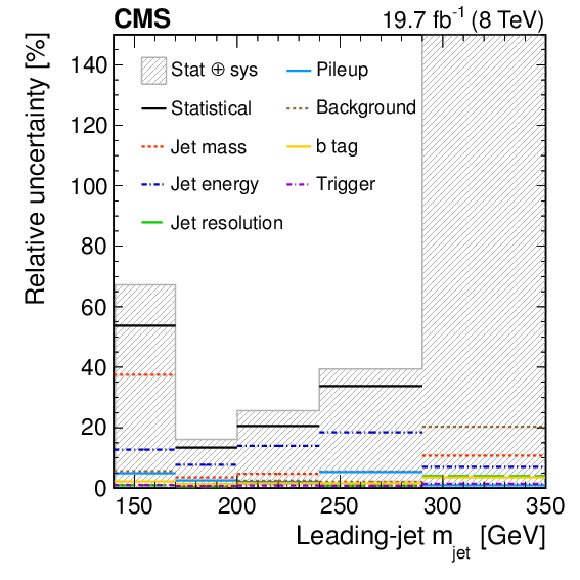
png pdf |
Figure 4-a:
Statistical uncertainties compared to the individual experimental systematic uncertainties, as a function of the leading-jet mass. The total uncertainties are indicated by the grey cross-hatched regions. The statistical and total uncertainties in the last bin are around 300% and exceed the vertical scale. The size of the horizontal bars represents the bin widths. |

png pdf |
Figure 4-b:
Statistical uncertainties compared to the systematic uncertainties originating from the modelling of ${\mathrm{ t }\mathrm{ \bar{t} } }$ production, as a function of the leading-jet mass. The total uncertainties are indicated by the grey cross-hatched regions. The statistical and total uncertainties in the last bin are around 300% and exceed the vertical scale. The size of the horizontal bars represents the bin widths. |
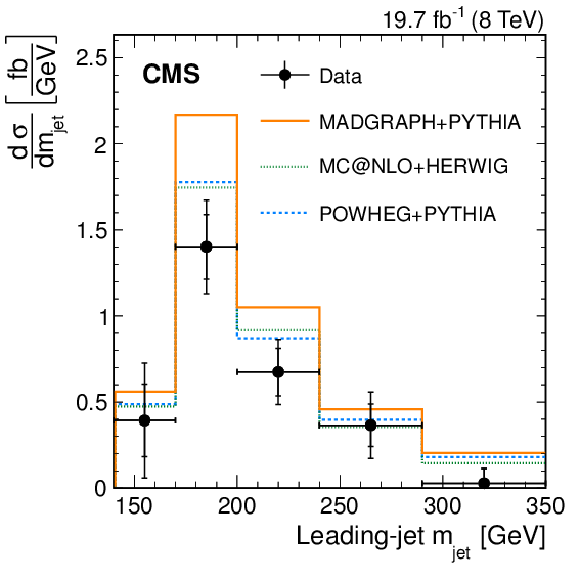
png pdf |
Figure 5:
Fiducial-region particle-level differential ${\mathrm{ t }\mathrm{ \bar{t} } }$ cross sections as a function of the leading-jet mass. The cross sections from the combined electron and muon channels (points) are compared to predictions from the MadGraph+PYTHIA, POWHEG+PYTHIA, and MC@NLO+HERWIG generators (lines). The vertical bars represent the statistical (inner) and the total (outer) uncertainties. The horizontal bars show the bin widths. |
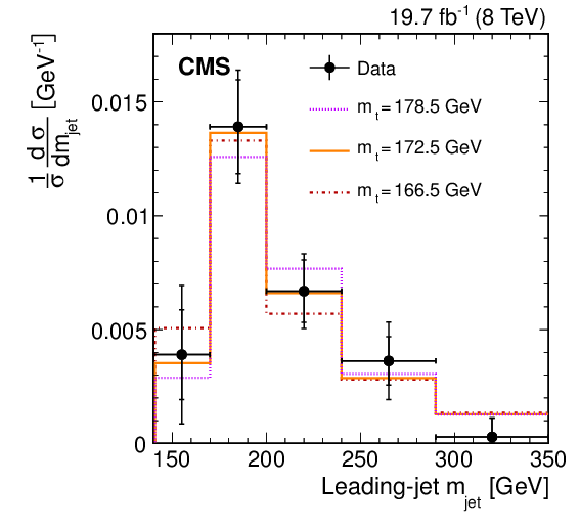
png pdf |
Figure 6:
The normalised particle-level ${\mathrm{ t }\mathrm{ \bar{t} } }$ differential cross section in the fiducial region as a function of the leading-jet mass. The measurement is compared to predictions from MadGraph+PYTHIA for three values of ${m_{\mathrm{ t } }} $. The vertical bars represent the statistical (inner) and the total (outer) uncertainties. The horizontal bars show the bin widths. |
| Tables | |
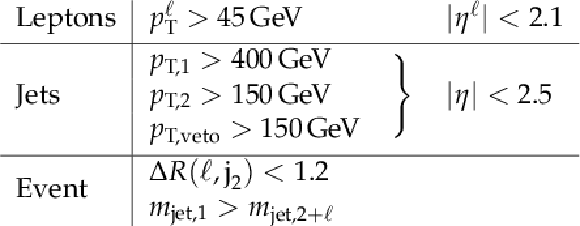
png pdf |
Table 1:
Summary of the selection criteria used to define the fiducial region of the measurement. |

png pdf |
Table 2:
Measured particle-level ${\mathrm{ t }\mathrm{ \bar{t} } }$ differential cross sections in the fiducial region as a function of ${m_{\text {jet}}} $, with the individual and total uncertainties in percent. |

png pdf |
Table 3:
Values of the particle-level ${\mathrm{ t }\mathrm{ \bar{t} } }$ differential cross section in the fiducial region, normalized to unity, as a function of the leading-jet mass. The individual and total uncertainties are given in percent. |

png pdf |
Table 4:
Covariance matrix for the statistical uncertainties in the differential cross section. All entries are given in units of [fb$^2$]. |

png pdf |
Table 5:
Covariance matrix for the total uncertainties in the differential cross section, including all systematic and modelling uncertainties. All entries are given in units of [fb$^2$]. |

png pdf |
Table 6:
Covariance matrix for the statistical uncertainties in the normalised differential cross section. All entries are given in units of [10$^{-4}$]. |

png pdf |
Table 7:
Covariance matrix for the total uncertainties in the normalised differential cross section, including all systematic and modelling uncertainties. All entries are given in units of [10$^{-4}$]. |
| Summary |
|
The first measurement of the differential $\mathrm{ t \bar{t} }$ cross section has been performed in the $\ell$+jets channel as a function of the leading-jet mass ${m_{\text{jet}}} $ in the highly boosted top quark regime. The measurement is carried out in a fiducial region with fully merged top quark decays in hadronic final states, corrected to the particle level. The normalised differential cross section as a function of ${m_{\text{jet}}} $ agrees with predictions from simulations, indicating the good quality of modelling the jet mass in highly boosted top quark decays. The total fiducial-region cross section for ${m_{\text{jet}}} $ between 140 and 350 GeV is measured to be 101 $\pm$ 19 fb, which is below the predicted value. This difference is consistent with earlier measurements of a softer top quark $p_{\mathrm{T}}$ spectrum observed in data than in simulation [10,11]. The peak position in the ${m_{\text{jet}}} $ distribution is sensitive to the top quark mass ${m_{\mathrm{ t }}} $. This can be used for an independent determination of ${m_{\mathrm{ t }}} $ in the boosted regime, with the prospect of reaching a more reliable correspondence between the top quark mass in any well-defined renormalisation scheme and the top quark mass parameter in general-purpose event generators. The normalised particle-level $\mathrm{ t \bar{t} }$ differential cross section measurement as a function of ${m_{\text{jet}}} $ is used to extract a value of ${m_{\mathrm{ t }}} $ in order to estimate the current sensitivity of the data. The value obtained, ${m_{\mathrm{ t }}} =$ 170.8 $\pm$ 9.0 GeV, is consistent with the current LHC and Tevatron average of 173.34 $\pm$ 0.27 (stat) $\pm$ 0.71 (syst) GeV [111], albeit with a much larger uncertainty. New data at higher centre-of-mass energies and with larger integrated luminosities will lead to an improvement in the statistical uncertainty. More data can also lead to reductions in the experimental systematic uncertainties, most notably that from the jet mass scale, which is expected to improve with smaller jet distance parameters. In addition, improvements in the modelling uncertainty are expected because of stronger constraints on the simulation in the highly boosted regime. A reduction in the theoretical uncertainty is also foreseen with the emergence of higher-order calculations. The results obtained in this analysis show the feasibility of the method to obtain the top quark mass in the highly boosted regime. This can provide an important ingredient for studies of the relation between the value of the top quark mass obtained from MC event generators and the one obtained from first-principle calculations. |
| References | ||||
| 1 | D0 Collaboration | Dependence of the $ \mathrm{t}\bar{\mathrm{t}} $ production cross section on the transverse momentum of the top quark | PLB 693 (2010) 515 | 1001.1900 |
| 2 | CMS Collaboration | Measurement of differential top-quark-pair production cross sections in pp colisions at $ \sqrt{s}= $ 7 TeV | EPJC 73 (2013) 2339 | CMS-TOP-11-013 1211.2220 |
| 3 | CDF Collaboration | Measurement of the differential cross section $ d{\sigma}/d(\cos{\theta}_t) $ for top-quark pair production in $ \mathrm{p}\overline{\mathrm{p}} $ collisions at $ \sqrt{s}= $ 1.96 TeV | PRL 111 (2013) 182002 | 1306.2357 |
| 4 | D0 Collaboration | Measurement of differential $ \mathrm{t}\bar{\mathrm{t}} $ production cross sections in $ \mathrm{p}\overline{\mathrm{p}} $ collisions | PRD 90 (2014) 092006 | 1401.5785 |
| 5 | ATLAS Collaboration | Measurements of normalized differential cross sections for $ \mathrm{t}\bar{\mathrm{t}} $ production in pp collisions at $ \sqrt{s}= $ 7 TeV using the ATLAS detector | PRD 90 (2014) 072004 | 1407.0371 |
| 6 | ATLAS Collaboration | Differential top-antitop cross-section measurements as a function of observables constructed from final-state particles using pp collisions at $ \sqrt{s}= $ 7 TeV in the ATLAS detector | JHEP 06 (2015) 100 | 1502.05923 |
| 7 | CMS Collaboration | Measurement of the differential cross section for top quark pair production in pp collisions at $ \sqrt{s}= $ 8 TeV | EPJC 75 (2015) 542 | CMS-TOP-12-028 1505.04480 |
| 8 | CMS Collaboration | Measurement of the $ \mathrm{t}\overline{{\mathrm{t}}} $ production cross section in the all-jets final state in pp collisions at $ \sqrt{s}= $ 8 TeV | EPJC 76 (2016) 128 | CMS-TOP-14-018 1509.06076 |
| 9 | ATLAS Collaboration | Measurement of top quark pair differential cross-sections in the dilepton channel in pp collisions at $ \sqrt{s} $ = 7 and 8 TeV with ATLAS | PRD 94 (2016), no. 9, 092003 | 1607.07281 |
| 10 | ATLAS Collaboration | Measurement of the differential cross-section of highly boosted top quarks as a function of their transverse momentum in $ \sqrt{s}= $ 8 TeV proton-proton collisions using the ATLAS detector | PRD 93 (2016) 032009 | 1510.03818 |
| 11 | CMS Collaboration | Measurement of the integrated and differential $ \mathrm{ t \bar{t} } $ production cross sections for high-$ p_\mathrm{T} $ top quarks in pp collisions at $ \sqrt{s}= $ 8 TeV | PRD 94 (2016) 072002 | CMS-TOP-14-012 1605.00116 |
| 12 | CMS Collaboration | Search for anomalous $ \mathrm{ t \bar{t} } $ production in the highly-boosted all-hadronic final state | JHEP 09 (2012) 029 | CMS-EXO-11-006 1204.2488 |
| 13 | ATLAS Collaboration | A search for $ \mathrm{ t \bar{t} } $ resonances in lepton+jets events with highly boosted top quarks collected in pp collisions at $ \sqrt{s}= $ 7 TeV with the ATLAS detector | JHEP 09 (2012) 041 | 1207.2409 |
| 14 | ATLAS Collaboration | Search for resonances decaying into top-quark pairs using fully hadronic decays in pp collisions with ATLAS at $ \sqrt{s}= $ 7 TeV | JHEP 01 (2013) 116 | 1211.2202 |
| 15 | ATLAS Collaboration | Search for $ \mathrm{ t \bar{t} } $ resonances in the lepton plus jets final state with ATLAS using 4.7 fb$ ^{-1} $ of $ pp $ collisions at $ \sqrt{s}= $ 7 TeV | PRD 88 (2013) 012004 | 1305.2756 |
| 16 | CMS Collaboration | Searches for New Physics Using the $ t\overline{t} $ Invariant Mass Distribution in $ pp $ Collisions at $ \sqrt{s}= $ 8 TeV | PRL 111 (2013) 211804 | CMS-B2G-13-001 1309.2030 |
| 17 | ATLAS Collaboration | Search for $ {W}' \rightarrow {tb} \rightarrow {qqbb} $ decays in $ pp $ collisions at $ \sqrt{s}= $ 8 TeV with the ATLAS detector | EPJC 75 (2015) 165 | 1408.0886 |
| 18 | CMS Collaboration | Search for vector-like T quarks decaying to top quarks and Higgs bosons in the all-hadronic channel using jet substructure | JHEP 06 (2015) 080 | CMS-B2G-14-002 1503.01952 |
| 19 | ATLAS Collaboration | A search for $ t\overline{t} $ resonances using lepton-plus-jets events in proton-proton collisions at $ \sqrt{s}= $ 8 TeV with the ATLAS detector | JHEP 08 (2015) 148 | 1505.07018 |
| 20 | CMS Collaboration | Search for resonant $ t\bar{t} $ production in proton-proton collisions at $ \sqrt{s}= $ 8 TeV | PRD 93 (2016) 012001 | CMS-B2G-13-008 1506.03062 |
| 21 | CMS Collaboration | Search for the production of an excited bottom quark decaying to tW in proton-proton collisions at $ \sqrt{s}= $ 8 TeV | JHEP 01 (2016) 166 | CMS-B2G-14-005 1509.08141 |
| 22 | ATLAS Collaboration | Search for the production of single vector-like and excited quarks in the $ Wt $ final state in $ pp $ collisions at $ \sqrt{s}= $ 8 TeV with the ATLAS detector | JHEP 02 (2016) 110 | 1510.02664 |
| 23 | ATLAS Collaboration | Jet mass and substructure of inclusive jets in $ \sqrt{s}= $ 7 TeV $ pp $ collisions with the ATLAS experiment | JHEP 05 (2012) 128 | 1203.4606 |
| 24 | CMS Collaboration | Studies of jet mass in dijet and W/Z + jet events | JHEP 05 (2013) 090 | CMS-SMP-12-019 1303.4811 |
| 25 | A. H. Hoang and I. W. Stewart | Top mass measurements from jets and the Tevatron top-quark mass | NPPS 185 (2008) 220 | 0808.0222 |
| 26 | CDF and D0 Collaborations | Combination of the top-quark mass measurements from the Tevatron collider | PRD 86 (2012) 092003 | 1207.1069 |
| 27 | ATLAS Collaboration | Measurement of the top quark mass in the $ t\bar{t}\rightarrow \text{ lepton+jets } $ and $ t\bar{t}\rightarrow \text{ dilepton } $ channels using $ \sqrt{s}= $ 7 TeV ATLAS data | EPJC 75 (2015) 330 | 1503.05427 |
| 28 | ATLAS Collaboration | Determination of the top-quark pole mass using $ \mathrm{ t \bar{t} } $+1-jet events collected with the ATLAS experiment in 7 TeV pp collisions | JHEP 10 (2015) 121 | 1507.01769 |
| 29 | CMS Collaboration | Measurement of the top quark mass using proton-proton data at $ {\sqrt{s}} = $ 7 and 8 TeV | PRD 93 (2016) 072004 | CMS-TOP-14-022 1509.04044 |
| 30 | CMS Collaboration | Measurement of the top quark mass using charged particles in $ pp $ collisions at $ \sqrt{s}= $ 8 TeV | PRD 93 (2016) 092006 | CMS-TOP-12-030 1603.06536 |
| 31 | ATLAS Collaboration | Measurement of the top quark mass in the $ t\bar{t}\to \text{dilepton} $ channel from $ \sqrt{s}= $ 8 TeV ATLAS data | PLB 761 (2016) 350 | 1606.02179 |
| 32 | C. W. Bauer, S. Fleming, and M. E. Luke | Summing Sudakov logarithms in $ B \to X_s + \gamma $ in effective field theory | PRD 63 (2000) 014006 | hep-ph/0005275 |
| 33 | C. W. Bauer, S. Fleming, D. Pirjol, and I. W. Stewart | An effective field theory for collinear and soft gluons: Heavy to light decays | PRD 63 (2001) 114020 | hep-ph/0011336 |
| 34 | C. W. Bauer and I. W. Stewart | Invariant operators in collinear effective theory | PLB 516 (2001) 134 | hep-ph/0107001 |
| 35 | C. W. Bauer, D. Pirjol, and I. W. Stewart | Soft-collinear factorization in effective field theory | PRD 65 (2002) 054022 | hep-ph/0109045 |
| 36 | S. Fleming, A. H. Hoang, S. Mantry, and I. W. Stewart | Jets from massive unstable particles: Top-mass determination | PRD 77 (2008) 074010 | hep-ph/0703207 |
| 37 | S. Fleming, A. H. Hoang, S. Mantry, and I. W. Stewart | Top jets in the peak region: Factorization analysis with next-to-leading-log resummation | PRD 77 (2008) 114003 | 0711.2079 |
| 38 | A. H. Hoang, A. Pathak, P. Pietrulewicz, and I. W. Stewart | Hard matching for boosted tops at two loops | JHEP 12 (2015) 059 | 1508.04137 |
| 39 | M. Butenschoen et al. | Top quark mass calibration for Monte Carlo event generators | PRL 117 (2016) 232001 | 1608.01318 |
| 40 | S. Moch et al. | High precision fundamental constants at the TeV scale | in Proceedings of the Mainz Institute for Theoretical Physics (MITP) scientific program on high precision fundamental constants at the TeV scale, March 10-21 2014 | 1405.4781 |
| 41 | A. H. Hoang | The top mass: Interpretation and theoretical uncertainties | in 7th International Workshop on Top Quark Physics (TOP2014) Cannes, France 2014 | 1412.3649 |
| 42 | G. Corcella | Interpretation of the top-quark mass measurements: A theory overview | in 8th International Workshop on Top Quark Physics (TOP2015) Ischia, Italy 2015 | 1511.08429 |
| 43 | Y. L. Dokshitzer, G. D. Leder, S. Moretti, and B. R. Webber | Better jet clustering algorithms | JHEP 08 (1997) 001 | hep-ph/9707323 |
| 44 | M. Wobisch and T. Wengler | Hadronization corrections to jet cross sections in deep-inelastic scattering | in Monte Carlo generators for HERA physics, Hamburg, Germany 1998 | hep-ph/9907280 |
| 45 | CMS Collaboration | The CMS trigger system | JINST 12 (2017) P01020 | CMS-TRG-12-001 1609.02366 |
| 46 | CMS Collaboration | The CMS experiment at the CERN LHC | JINST 3 (2008) S08004 | CMS-00-001 |
| 47 | CMS Collaboration | Particle-flow event reconstruction in CMS and performance for jets, taus, and $ E_{\mathrm{T}}^{\text{miss}} $ | CDS | |
| 48 | CMS Collaboration | Commissioning of the particle-flow event reconstruction with the first LHC collisions recorded in the CMS detector | CDS | |
| 49 | CMS Collaboration | Description and performance of track and primary-vertex reconstruction with the CMS tracker | JINST 9 (2014) P10009 | CMS-TRK-11-001 1405.6569 |
| 50 | CMS Collaboration | Performance of CMS muon reconstruction in pp collision events at $ \sqrt{s}= $ 7 TeV | JINST 7 (2012) P10002 | CMS-MUO-10-004 1206.4071 |
| 51 | CMS Collaboration | The performance of the CMS muon detector in proton-proton collisions at $ \sqrt{s}= $ 7 TeV at the LHC | JINST 8 (2013) P11002 | CMS-MUO-11-001 1306.6905 |
| 52 | CMS Collaboration | Performance of electron reconstruction and selection with the CMS detector in proton-proton collisions at $ \sqrt{s}= $ 8 TeV | JINST 10 (2015) P06005 | CMS-EGM-13-001 1502.02701 |
| 53 | CMS Collaboration | Energy calibration and resolution of the CMS electromagnetic calorimeter in pp collisions at $ \sqrt{s}= $ 7 TeV | JINST 8 (2013) P09009 | CMS-EGM-11-001 1306.2016 |
| 54 | M. Cacciari, G. P. Salam, and G. Soyez | FastJet user manual | EPJC 72 (2012) 1896 | 1111.6097 |
| 55 | M. Cacciari, G. P. Salam, and G. Soyez | The anti-$ k_t $ jet clustering algorithm | JHEP 04 (2008) 063 | 0802.1189 |
| 56 | M. Cacciari, G. P. Salam, and G. Soyez | The catchment area of jets | JHEP 04 (2008) 005 | 0802.1188 |
| 57 | CMS Collaboration | Determination of jet energy calibration and transverse momentum resolution in CMS | JINST 6 (2011) P11002 | CMS-JME-10-011 1107.4277 |
| 58 | CMS Collaboration | Jet energy scale and resolution in the CMS experiment in pp collisions at 8 TeV | Submitted to JINST | CMS-JME-13-004 1607.03663 |
| 59 | CMS Collaboration | Identification of b-quark jets with the CMS experiment | JINST 8 (2013) P04013 | CMS-BTV-12-001 1211.4462 |
| 60 | CMS Collaboration | Jet performance in pp collisions at 7 TeV | CDS | |
| 61 | CMS Collaboration | Missing transverse energy performance of the CMS detector | JINST 6 (2011) P09001 | CMS-JME-10-009 1106.5048 |
| 62 | P. Nason | A new method for combining NLO QCD with shower Monte Carlo algorithms | JHEP 11 (2004) 040 | hep-ph/0409146 |
| 63 | S. Frixione, P. Nason, and C. Oleari | Matching NLO QCD computations with parton shower simulations: The POWHEG method | JHEP 11 (2007) 070 | 0709.2092 |
| 64 | S. Alioli, P. Nason, C. Oleari, and E. Re | A general framework for implementing NLO calculations in shower Monte Carlo programs: The POWHEG BOX | JHEP 06 (2010) 043 | 1002.2581 |
| 65 | S. Alioli, P. Nason, C. Oleari, and E. Re | NLO single-top production matched with shower in POWHEG: $ s $- and $ t $-channel contributions | JHEP 09 (2009) 111 | 0907.4076 |
| 66 | E. Re | Single-top Wt-channel production matched with parton showers using the POWHEG method | EPJC 71 (2011) 1547 | 1009.2450 |
| 67 | J. Alwall et al. | The automated computation of tree-level and next-to-leading order differential cross sections, and their matching to parton shower simulations | JHEP 07 (2014) 079 | 1405.0301 |
| 68 | P. Artoisenet, R. Frederix, O. Mattelaer, and R. Rietkerk | Automatic spin-entangled decays of heavy resonances in Monte Carlo simulations | JHEP 03 (2013) 015 | 1212.3460 |
| 69 | T. Sjostrand, S. Mrenna, and P. Skands | PYTHIA 6.4 physics and manual | JHEP 05 (2006) 026 | hep-ph/0603175 |
| 70 | S. Frixione and B. R. Webber | Matching NLO QCD computations and parton shower simulations | JHEP 06 (2002) 029 | hep-ph/0204244 |
| 71 | M. L. Mangano, M. Moretti, F. Piccinini, and M. Treccani | Matching matrix elements and shower evolution for top-quark production in hadronic collisions | JHEP 01 (2007) 013 | hep-ph/0611129 |
| 72 | P. M. Nadolsky et al. | Implications of CTEQ global analysis for collider observables | PRD 78 (2008) 013004 | 0802.0007 |
| 73 | H.-L. Lai et al. | New parton distributions for collider physics | PRD 82 (2010) 074024 | 1007.2241 |
| 74 | J. Pumplin et al. | New generation of parton distributions with uncertainties from global QCD analysis | JHEP 07 (2002) 012 | hep-ph/0201195 |
| 75 | CMS Collaboration | Study of the underlying event at forward rapidity in pp collisions at $ \sqrt{s} = $ 0.9, 2.76, and 7 TeV | JHEP 04 (2013) 072 | CMS-FWD-11-003 1302.2394 |
| 76 | CMS Collaboration | Event generator tunes obtained from underlying event and multiparton scattering measurements | EPJC 76 (2016) 155 | CMS-GEN-14-001 1512.00815 |
| 77 | G. Corcella et al. | HERWIG 6: An event generator for hadron emission reactions with interfering gluons (including supersymmetric processes) | JHEP 01 (2001) 010 | hep-ph/0011363 |
| 78 | N. Kidonakis | NNLL threshold resummation for top-pair and single-top production | Phys. Part. Nucl. 45 (2014) 714 | 1210.7813 |
| 79 | R. Gavin, Y. Li, F. Petriello, and S. Quackenbush | FEWZ 2.0: A code for hadronic Z production at next-to-next-to-leading order | CPC 182 (2011) 2388 | 1011.3540 |
| 80 | R. Gavin, Y. Li, F. Petriello, and S. Quackenbush | W physics at the LHC with FEWZ 2.1 | CPC 184 (2013) 208 | 1201.5896 |
| 81 | Y. Li and F. Petriello | Combining QCD and electroweak corrections to dilepton production in the framework of the FEWZ simulation code | PRD 86 (2012) 094034 | 1208.5967 |
| 82 | J. M. Campbell, R. K. Ellis, and K. Williams | Vector boson pair production at the LHC | JHEP 07 (2011) 018 | 1105.0020 |
| 83 | M. Beneke, P. Falgari, S. Klein, and C. Schwinn | Hadronic top-quark pair production with NNLL threshold resummation | Nucl. Phys. B 855 (2012) 695 | 1109.1536 |
| 84 | M. Cacciari et al. | Top-pair production at hadron colliders with next-to-next-to-leading logarithmic soft-gluon resummation | PLB 710 (2012) 612 | 1111.5869 |
| 85 | P. Barnreuther, M. Czakon, and A. Mitov | Percent-level-precision physics at the Tevatron: Next-to-leading order QCD corrections to $ \mathrm{q} \bar{\mathrm{q}} \to \mathrm{ t \bar{t} }$+X | PRL 109 (2012) 132001 | 1204.5201 |
| 86 | M. Czakon and A. Mitov | NNLO corrections to top-pair production at hadron colliders: The all-fermionic scattering channels | JHEP 12 (2012) 054 | 1207.0236 |
| 87 | M. Czakon and A. Mitov | NNLO corrections to top pair production at hadron colliders: The quark-gluon reaction | JHEP 01 (2013) 080 | 1210.6832 |
| 88 | M. Czakon, P. Fiedler, and A. Mitov | Total top-quark pair-production cross section at hadron colliders through $ \mathcal{O}(\alpha^4_{S}) $ | PRL 110 (2013) 252004 | 1303.6254 |
| 89 | M. Czakon and A. Mitov | Top++: A program for the calculation of the top-pair cross-section at hadron colliders | CPC 185 (2014) 2930 | 1112.5675 |
| 90 | GEANT4 Collaboration | GEANT4 -- a simulation toolkit | NIMA 506 (2003) 250 | |
| 91 | CMS Collaboration | Performance of the CMS missing transverse momentum reconstruction in pp data at $ \sqrt{s}= $ 8 TeV | JINST 10 (2015) P02006 | CMS-JME-13-003 1411.0511 |
| 92 | J. Thaler and K. Van Tilburg | Identifying boosted objects with $ N $-subjettiness | JHEP 03 (2011) 015 | 1011.2268 |
| 93 | J. Thaler and K. Van Tilburg | Maximizing boosted top identification by minimizing $ N $-subjettiness | JHEP 02 (2012) 093 | 1108.2701 |
| 94 | D. E. Kaplan, K. Rehermann, M. D. Schwartz, and B. Tweedie | Top tagging: A method for identifying boosted hadronically decaying top quarks | PRL 101 (2008) 142001 | 0806.0848 |
| 95 | CMS Collaboration | A Cambridge-Aachen (C-A) based jet algorithm for boosted top-jet tagging | CDS | |
| 96 | T. Plehn, G. P. Salam, and M. Spannowsky | Fat jets for a light Higgs boson | PRL 104 (2010) 111801 | 0910.5472 |
| 97 | T. Plehn, M. Spannowsky, M. Takeuchi, and D. Zerwas | Stop reconstruction with tagged tops | JHEP 10 (2010) 078 | 1006.2833 |
| 98 | T. Lapsien, R. Kogler, and J. Haller | A new tagger for hadronically decaying heavy particles at the LHC | EPJC 76 (2016) 600 | 1606.04961 |
| 99 | Y.-T. Chien, R. Kelley, M. D. Schwartz, and H. X. Zhu | Resummation of jet mass at hadron colliders | PRD 87 (2013) 014010 | 1208.0010 |
| 100 | M. Dasgupta and G. P. Salam | Resummation of non-global QCD observables | PLB 512 (2001) 323 | hep-ph/0104277 |
| 101 | S. Schmitt | TUnfold: An algorithm for correcting migration effects in high energy physics | JINST 7 (2012) T10003 | 1205.6201 |
| 102 | S. Schmitt | Data unfolding methods in high energy physics | in 12th Conference on Quark Confinement and the Hadron Spectrum (Confinement XII) Thessaloniki, Greece 2016 | 1611.01927 |
| 103 | G. Antchev et al. | First measurement of the total proton-proton cross section at the LHC energy of $ \sqrt{s} = $ 7 TeV | Europhys. Lett. 96 (2011) 21002 | 1110.1395 |
| 104 | CMS Collaboration | Measurement of the production cross section of the W boson in association with two b jets in pp collisions at $ \sqrt{s}= $ 8 TeV | Submitted to EPJC | CMS-SMP-14-020 1608.07561 |
| 105 | CMS Collaboration | Observation of the associated production of a single top quark and a W boson in pp collisions at $ \sqrt{s}= $ 8 TeV | PRL 112 (2014) 231802 | CMS-TOP-12-040 1401.2942 |
| 106 | CMS Collaboration | CMS luminosity based on pixel cluster counting - summer 2013 update | CMS-PAS-LUM-13-001 | CMS-PAS-LUM-13-001 |
| 107 | M. Czakon, D. Heymes, and A. Mitov | High-precision differential predictions for top-quark pairs at the LHC | PRL 116 (2016) 082003 | 1511.00549 |
| 108 | ATLAS Collaboration | Measurement of the $ \mathrm{ t \bar{t} } $ production cross-section using e$ \mu $ events with b-tagged jets in pp collisions at $ \sqrt{s}= $ 7 and 8 TeV with the ATLAS detector | EPJC 74 (2014) 3109 | 1406.5375 |
| 109 | CMS Collaboration | Measurement of the $ \mathrm{t}\overline{{\mathrm{t}}} $ production cross section in the e$ \mu $ channel in proton-proton collisions at $ \sqrt{s} = $ 7 and 8 TeV | JHEP 08 (2016) 029 | CMS-TOP-13-004 1603.02303 |
| 110 | Gfitter Group | The global electroweak fit at NNLO and prospects for the LHC and ILC | EPJC 74 (2014) 3046 | 1407.3792 |
| 111 | ATLAS, CDF, CMS and D0 Collaborations | First combination of Tevatron and LHC measurements of the top-quark mass | 1403.4427 | |

|
Compact Muon Solenoid LHC, CERN |

|

|

|

|

|

|